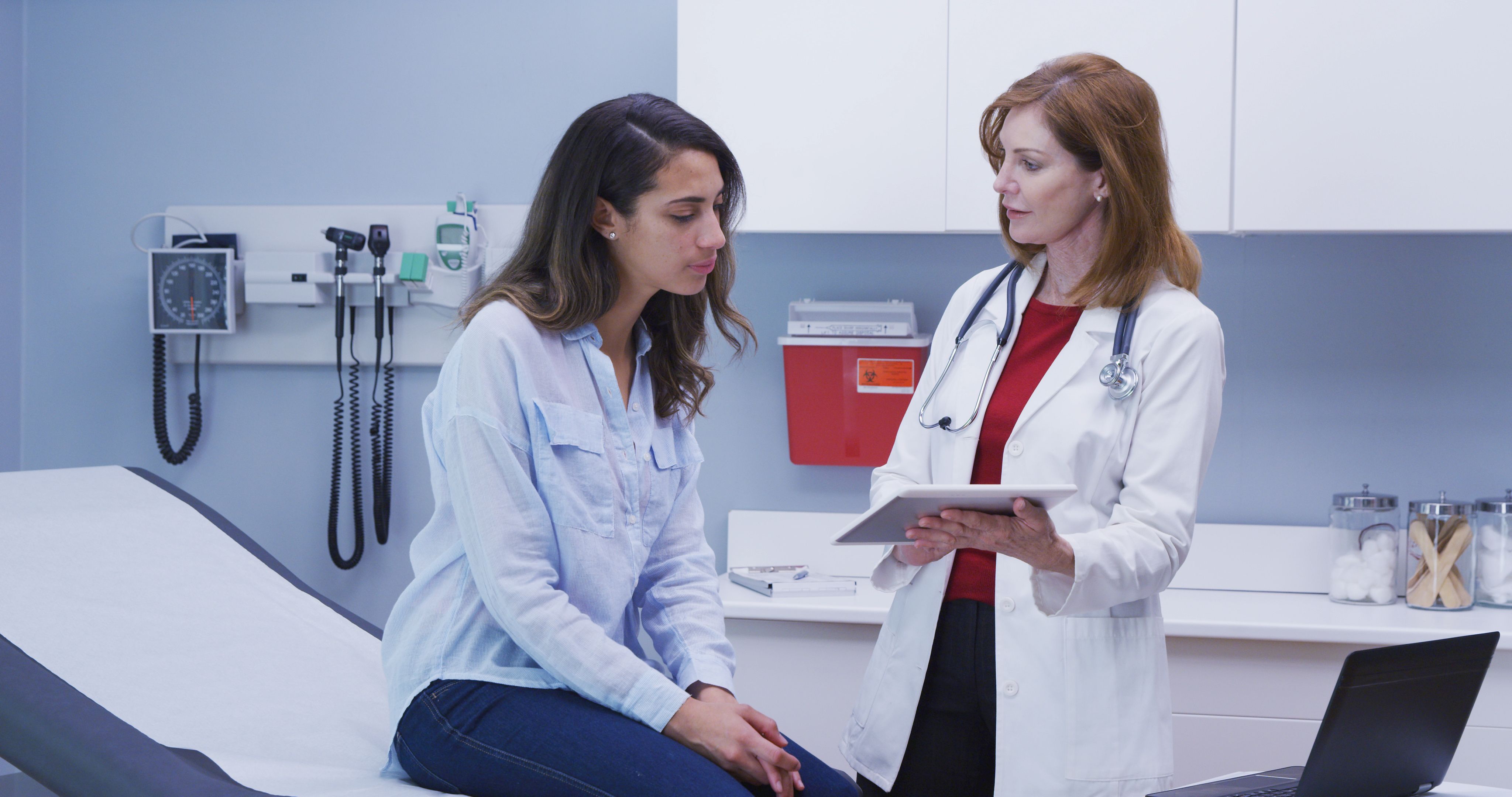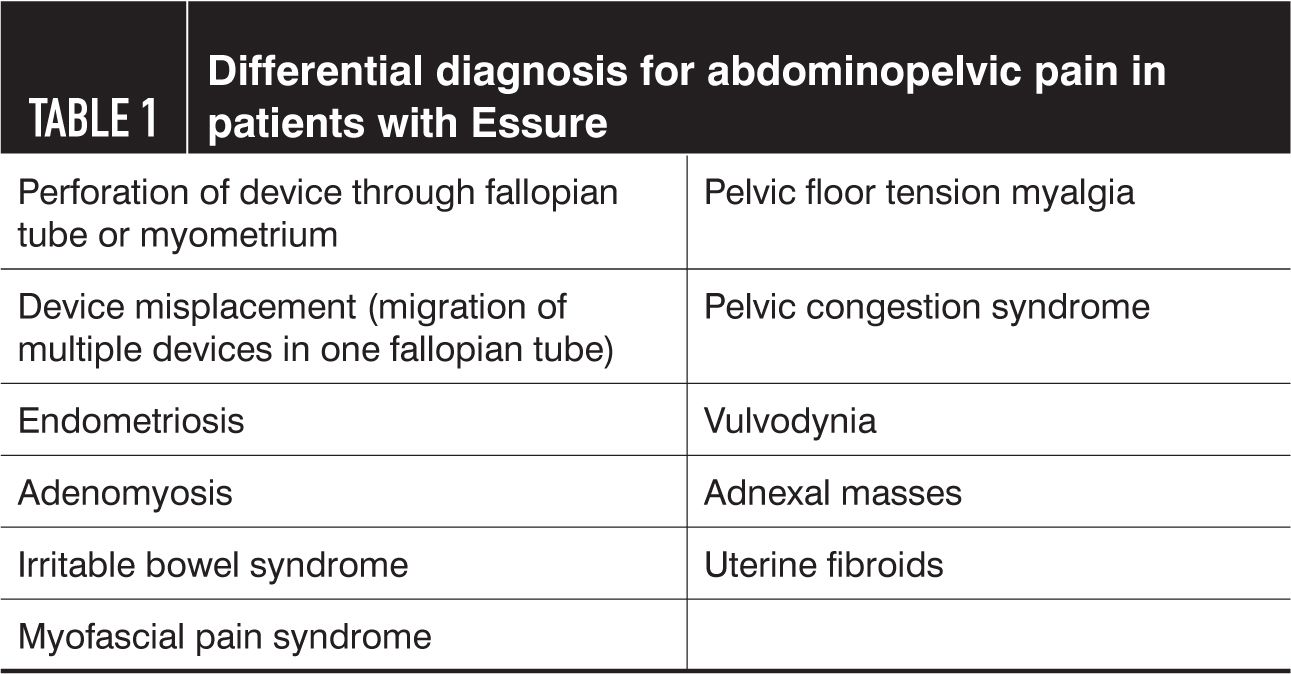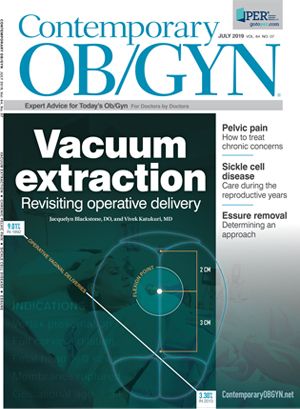Considerations when discussing Essure removal
When a patient is interested in having the device removed, her physician needs to examine several factors before deciding on a surgical approach.
©rocketclips - stock.adobe.com

Table 1

The recent removal of Essure from the US market has created concern among patients with the device about the reason for the manufacturer’s action. Many women also may have questions about whether to have the device removed. This article reviews the history, literature, and symptoms related to Essure as well as removal techniques to guide physicians through the counseling process.
Essure background
Essure is a hysteroscopic sterilization technique involving placement of nickel-titanium microinserts in the fallopian tubes. Over the course of
12 weeks, the microinserts cause fibrosis and occlusion of the fallopian tubes. Essure was approved by the US Food and Drug Administration (FDA) in 2002.1 Benefits of the technique were that it was a minimally invasive procedure that could be conveniently performed in the office without requiring general anesthesia or abdominal incisions and hormone-free sterilization. It was a safe option for women who had contraindications to general anesthesia or hormonal contraception or who wanted to avoid abdominal surgery.
Concerns about Essure
Increasing patient reports about Essure-related symptoms led to a growing number of safety concerns about the device. Patient concerns have ranged widely from hair loss to physical and mental disabilities.2 One retrospective cohort study found that the most commonly reported symptoms following Essure placement were abdominal pain, back pain, fatigue, leg and hip pain, dysmenorrhea, and heavy menstrual bleeding.3 Another retrospective case series revealed that pelvic pain, abnormal uterine bleeding (AUB), and a reported allergic reaction were the symptoms most commonly reported by women prior to undergoing Essure removal.4 Patients who reported allergic reactions prior to sterilization were at higher risk of developing an allergic reaction with hysteroscopic sterilization when compared to laparoscopic sterilization.5
For more information on Essure removal - Laparoscopic Essure Tubal Reversal: How We Do It
Websites and Facebook groups run by women with Essure who had symptoms, led to a public outcry against the device, specifically in regards to the polyethylene terephthalate (PET) fibers in the microinserts.6,7 In response, in 2015, the FDA appointed a special panel to investigate these claims, added a “black box” warning, and created stricter guidelines for placement.1 Continued complaints and stricter guidelines caused a significant decrease in the number of devices placed.8 Bayer removed Essure from the European market in September 20173 and from the US market in December 2018 due to the decrease in sales.1 In its announcement, Bayer stated that preventative removal for those without symptoms was unnecessary.1
Read more: Sales of controversial contraceptive implant to end
Device-related symptoms
Gynecologists may see patients who have multiple concerns about the Essure device, including a variety of symptoms and questions raised by recent media coverage. When a woman presents with an Essure-related complaint, it’s important to take a detailed history. Patients may report multiple symptoms that may or may not be associated with the device and each should be documented and assessed. For each symptom, we recommend determining whether it is localized or generalized and identifying the timing of onset, severity, aggravators, or relievers. Patients may experience symptom onset from immediately to several years after Essure placement. We recommend documenting treatment attempts, including non-pharmacologic and pharmacologic treatments. In addition, because patients may also seek care from other consulting providers-such as allergists, rheumatologists, gastroenterologists or neurologists-it may be beneficial to collaborate with these consultants to determine a care plan.
Office exam and work-up
For symptomatic patients, we recommend a detailed physical exam with a pelvic exam. It is particularly important to use a systematic approach to an abdominopelvic exam in cases of pain-related symptoms prior to surgery to eliminate other causes of pelvic pain. This type of exam includes an abdominal exam and may start with assessment of sensation with light touch or a pinprick. Next, lightly palpate to help identify any trigger points related to myofascial pelvic pain syndrome. Next, deep palpation can assess for any masses or hernias. Finally, assess for Carnett’s sign, which if positive, suggests an abdominal wall etiology. Pelvic exam should first include a Q-tip test along the external genitalia to evaluate for vulvodynia and assess sensation. Next, proceed with internal palpation of the obturator internus and levator ani to evaluate for pelvic floor myofascial pain. A bimanual exam can assess uterine size and adnexa. Finally, perform a speculum exam to observe for anatomic abnormalities or evaluate for infectious etiologies.9
Additional laboratory studies may be helpful in some patients. We recommend a work-up for AUB, which may include a complete blood count, thyroid screening, Pap test, and assessment of the endometrium with an endometrial biopsy. Transvaginal ultrasound (US) is helpful for diagnosis and surgical planning to evaluate uterine size, uterine structural abnormalities, or any adnexal masses.
VIDEO: Essure Removal Tips
In asymptomatic patients who present with concerns about safety of Essure following removal from the market, conversation and detailed education is necessary. A pelvic exam may or may not be indicated.
A range of imaging techniques can be used to evaluate microinsert placement, including ultrasonography, hysterosalpingography (HSG), and abdominal pelvic x-ray. Imaging can confirm placement of the device and may inform counseling regarding device removal or surgical technique. We recommend ultrasonography, as it may elucidate other causes of symptoms such as fibroids, endometrial polyps, or ovarian cysts such as endometriomas. In addition, ultrasonography may also show perforation of the device through the uterus or fallopian tubes. HSG and x-ray imaging can confirm tubal occlusion and evaluate the implants, with the possibility of revealing fractured implants.10
Surgical techniques
Several techniques for removal of Essure have been documented, including use of hysteroscopy, laparoscopic salpingectomy, cornuectomy, and total hysterectomy.5,11-13 The type of removal chosen may depend on a patient’s symptoms and comorbidities, and the surgeon’s skill and experience. When discussing surgery with a patient, it is important to elicit her concerns, including preference for an approach, recovery time, and desire for en bloc removal. Because most patients with Essure want permanent sterilization, we do not discuss fertility-preserving techniques here.
Hysteroscopic Essure removal can be an option up to 6 weeks after placement, before tubal occlusion has occurred.14 This method of removal can be performed in situations of acute post-procedural pain and may help avoid abdominal surgery. Hysteroscopic removal also can be performed in conjunction with a laparoscopic salpingectomy to ensure removal of all filaments.
Laparoscopic bilateral salpingectomy has been well-documented as a removal method; however, there is a theoretical risk of incomplete removal.13 This approach can often be performed with three 5-mm laparoscopic ports. The surgeon makes an incision in the fallopian tube with electrocautery approximately 1 cm from the cornua. The Essure device is then grasped and gentle traction is used to remove both the outer and inner coils from the cornua. Next, electrocautery is used along the mesosalpinx to remove the fallopian tube.15 Postoperative recovery time is usually 2 to 4 weeks. Benefits of this approach include the ability to diagnose and remove any pelvic pathology, that could also be contributing to the patient’s symptoms. This technique, however, has the potential to leave fragments of the microinsert device, PET fibers, in the pelvis or in the uterus as the microinsert is pulled from the cornua. In addition, we counsel patients that they may require another surgery if their symptoms continue postoperatively.
Laparoscopic cornuectomy with bilateral salpingectomy, an approach used to remove the microinsert and fallopian tubes en bloc, requires a laparoscopic surgeon trained in cornual wedge resection. It may require a 10-mm and two 5-mm laparoscopic ports, vasopressin for hemostasis, and suturing of the cornua in multiple layers. Although this technique has increased risks, including blood loss,34 patients may benefit from complete removal of the device. It may also be helpful in patients with symptoms concerning for allergic reaction. Patients may require 4 to 6 weeks for recovery.
Hysterectomy with bilateral salpingectomy will also remove the Essure inserts and can be done vaginally, laparoscopically or abdominally. This technique may be desirable for patients who also have symptoms of AUB and/or adenomyosis. Hysterectomy has the greatest surgical risk of all Essure removal techniques, including infection, hemorrhage, and ureteral injury. Recovery time for this method is the longest, at 6 to 8 weeks.4 In one study of women who underwent gynecologic surgery following Essure placement, hysterectomy was the most commonly performed surgery.12 This may be because it is the most likely to treat multiple symptoms, including Essure-related allergy, pelvic pain, and AUB.
Discussing postoperative outcomes
Several case studies and prospective and retrospective research have looked at symptom relief after Essure removal. Studies have reported that 40% of patients have complete resolution of symptoms when followed up to 3 years after removal via hysteroscopic, laparoscopic and laparotomy removal.3 This unfortunately means that most patients do not have complete resolution of symptoms after removal. In addition, 10% to 15% reported no change in symptoms, with abdominopelvic pain being the most commonly experienced symptom prior to and following the surgeries previously mentioned.3 Another study showed 75% improvement in quality-of-life following surgery, which was similar for patients undergoing laparoscopic bilateral salpingectomy or hysterectomy for removal.4 A number of case series have proven that patients with previous nickel allergy or who develop allergy after Essure placement have improved outcomes after laparoscopic or hysteroscopic removal.16 In a follow-up study of medical outcomes after sterilization, there was no difference in risk of developing an autoimmune disease with hysteroscopic versus laparoscopic sterilization.
One difficulty in assessing surgical success is that it may also be hard to distinguish between resolution due to removal due to placebo effect.
Patient-centered care
Patients with the Essure device may present with or without symptoms related to the microinsert. Women without symptoms should be counseled that they do not need to have their coils removed and that removal could cause increased risk of injury. Symptomatic patients who want counseling about Essure removal should be worked up for the most common differential diagnoses for their symptoms. A thorough history and physical exam is crucial to identifying possible causes. Specific labs, imaging, and consultation with multidisciplinary consultants may also assist with diagnoses unrelated to Essure. Counseling regarding methods of removal and outcomes associated with them are necessary for shared patient decision-making to achieve a patient’s desired outcomes.
Disclosures:
The authors report no potential conflicts of interest with regard to this article.
References:
- Bayer. Frequently Asked Questions About Essure. http://www.essure.com/faq. Accessed April 29, 2019.
- Banks C, et al. Increasing patient engagement in pharmocovigilance through online community outreach and mobile reporting applications: an analysis of adverse event reporting for the Essure Device in the US. Pharm Med. 2015;29(6):331-340.
- Maassen LW, van Gastel DM, Haveman I, Bongers MY, Veersema S. Removal of Essure sterilization devices: a retrospective cohort study in the Netherlands. J Minim Invasive Gynecol. 2018 Oct 16. pii: S1553-4650(18)31302-5.
- Clark NV, Rademaker D, Mushinski AA, Ajao MO, Cohen SL, Einarsson JI. Essure removal for the treatment of device-attributed symptoms: an expanded case series and follow-up survey. J Minim Invasive Gynecol. 2017;24(6):971-976.
- Bouillon K, Bertrand M, Bader G, Lucot JP, Dray-Spira R, Zureik M. Association of hysteroscopic vs laparoscopic sterilization with procedural, gynecological, and medical outcomes. JAMA. 2018;319(4):375-387.
- Advocating Safety in Healthcare E-Sisters (ASHES). https://www.ashesnonprofit.com/. Accessed April 29, 2019.
- Essure Problems. https://essureproblems.webs.com/. Accessed April 29, 2019.
- Bayer. New Release: Bayer to voluntarily discontinue U.S. sales of Essure at end of 2018 for business reasons. http://www.essure.com/assets/pdf/PP-250-US-1923-FINAL-News-Release.pdf. Accessed April 29, 2019.
- Meister MR, Sutcliffe S, Ghetti C, et al. Development of a standardized, reproducible screening examination for assessment of pelvic floor myofascial pain. Am J Obstet Gynecol. 2019;220(3):255.e1-255.e9.
- Sills ES, Dalton MM. Referrals for complications following hysteroscopic sterilisation: characteristics associated with symptomatic patients after the Essure procedure. Eur J Contracept Reprod Health Care. 2016;21(3):227-233.
- Charavil A, Agostini A, Rambeaud C, Schmitt A, Tourette C, Crochet P. Vaginal hysterectomy with salpingectomy for Essure insert removal. J Minim Invasive Gynecol. 2019;26(4):695-701.
- Sills ES, Li X, Wood SH, Jones CA. Analysis of surgeries performed after hysteroscopic sterilization as tabulated from 3,803 Essure patient experiences. Obstet Gynecol Sci. 2017;60(3):296-302.
- Thiel L, Rattray D, Thiel J. Laparoscopic cornuectomy as a technique for removal of Essure microinserts. J Minim Invasive Gynecol. 2017;24(1):10.
- Albright CM, Frishman GN, Bhagavath B. Surgical aspects of removal of Essure microinsert. Contraception. 2013;88(3):334-336.
- Lazorwitz A, Tocce K. A case series of removal of nickel-titanium sterilization microinserts from the uterine cornua using laparoscopic electrocautery for salpingectomy. Contraception. 2017;96(2):96-98.
- Lane A, Tyson A, Thurston E. Providing Re-Essure-ance to the nickel-allergic patient considering hysteroscopic sterilization. J Minim Invasive Gynecol. 2016;23(1):126-129.

Recap on reproductive rights with David Hackney, MD, MS
December 20th 2022In this episode of Pap Talk, we spoke with David Hackney, MD, MS, maternal-fetal medicine physician at Case Western Reserve University and chair of ACOG's Ohio chapter for a full recap of where restrictions on reproductive rights have been and where they're going.
Listen
In this episode of Pap Talk, Gloria Bachmann, MD, MSc, breaks down what it means to be a health care provider for incarcerated individuals, and explores the specific challenges women and their providers face during and after incarceration. Joined by sexual health expert Michael Krychman, MD, Bachmann also discusses trauma-informed care and how providers can get informed.
Listen
No link found between hormonal contraception and clitoral adhesion severity
February 28th 2025A recent study presented at the ISSWSH 2025 Annual Meeting found no significant association between hormonal contraceptive use and the severity of clitoral adhesions, though researchers emphasize the need for further investigation.
Read More
